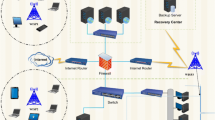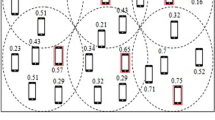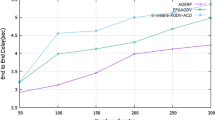Abstract
The group of ad hoc nodes without any infrastructure is a mobile ad hoc network (MANET). The nodes in these networks move and provide regular outcomes as a result of the frequent topological changes. Ad hoc networks' dynamic topological changes may be managed by using appropriate routing protocols, which improve network performance. In this study, we have presented novel energy-efficient routing models in MANET. The proposed methodology includes three major phases namely relay node selection, shortest pathfinding, and path maintenance. The fuzzy-based analytic hierarchy process with Technique for Order of Preference by Similarity to Ideal Solution (TOPSIS) (Fuzzy-AHP with TOPSIS) method is used for relay or intermediate node selection. After that, the Hybrid Capuchin Search-based Emperor Penguin and Salp Swarm (HCS-EPS2) algorithm effectively select the shortest path. Finally, path maintenance is carried out, and mobile nodes are used to communicate with neighbors by exchanging hello packets. The experimental results were conducted for the proposed model in terms of throughput, energy efficiency, packet delivery ratio, routing overhead, and end-to-end delay. When compared to the existing techniques, the packet arrival rate, end-to-end latency, and communication overhead are improved to 20, 40, and 30%, respectively.













Similar content being viewed by others
Availability of data and material
Data sharing is not applicable to this article as no new data were created or analyzed in this study.
References
Yu, C., Lee, B., & Yong Youn, H. (2003). Energy efficient routing protocols for mobile ad hoc networks. Wireless Communications and Mobile Computing, 3(8), 959–973.
Sharma, A. S., & Kim, D. S. (2021). Energy efficient multipath ant colony based routing algorithm for mobile ad hoc networks. Ad Hoc Networks, 113, 102396.
Tilwari, V., Maheswar, R., Jayarajan, P., Sundararajan, T. V. P., Hindia, M. N., Dimyati, K., Ojukwu, H., & Amiri, I. S. (2020). MCLMR: A multicriteria based multipath routing in the mobile ad hoc networks. Wireless Personal Communications, 112(4), 2461–2483.
Robinson, Y. H., Balaji, S., & Julie, E. G. (2019). PSOBLAP: Particle swarm optimization-based bandwidth and link availability prediction algorithm for multipath routing in mobile ad hoc networks. Wireless Personal Communications, 106(4), 2261–2289.
Malar, A., Kowsigan, M., Krishnamoorthy, N., Karthick, S., Prabhu, E., & Venkatachalam, K. (2021). Multi constraints applied energy efficient routing technique based on ant colony optimization used for disaster resilient location detection in mobile ad-hoc network. Journal of Ambient Intelligence and Humanized Computing, 12(3), 4007–4017.
Alani, S., Zakaria, Z., & Lago, H. (2019). A new energy consumption technique for mobile ad hoc networks. International Journal of Electrical and Computer Engineering, 9(5), 4147.
Singh, P., Khari, M., & Vimal, S. (2021). EESSMT: An energy efficient hybrid scheme for securing mobile ad hoc networks using IoT. Wireless Personal Communications, pp.1–25.
Kuo, W. K., & Chu, S. H. (2016). Energy efficiency optimization for mobile ad hoc networks. IEEE Access, 4, 928–940.
Robinson, Y. H., Balaji, S., & Julie, E. G. (2019). FPSOEE: Fuzzy-enabled particle swarm optimization-based energy-efficient algorithm in mobile ad-hoc networks. Journal of Intelligent & Fuzzy Systems, 36(4), 3541–3553.
Ali, H., Shahzad, W., & Khan, F. A. (2012). Energy-efficient clustering in mobile ad-hoc networks using multi-objective particle swarm optimization. Applied Soft Computing, 12(7), 1913–1928.
Bouhorma, M., Boudhir, A., Ahmed, M.B., & El Brak, S. (2011). New route request mechanism for energy optimization in Mobile Ad hoc Networks. In 2011 19th Telecommunications Forum (TELFOR) Proceedings of Papers (pp. 230–233). IEEE.
Hashempour, S., Suratgar, A. A., & Afshar, A. (2021). Distributed nonconvex optimization for energy efficiency in mobile Ad Hoc networks. IEEE Systems Journal, 15(4), 5683–5693.
Yang, D., **a, H., Xu, E., **g, D., & Zhang, H. (2018). Energy-balanced routing algorithm based on ant colony optimization for mobile ad hoc networks. Sensors, 18(11), 3657.
Singh, P. K., & Sarkar, P. (2019). A framework based on fuzzy AHP-TOPSIS for prioritizing solutions to overcome the barriers in the implementation of ecodesign practices in SMEs. International Journal of Sustainable Development & World Ecology, 26(6), 506–521.
Venkatesh, V. G., Zhang, A., Deakins, E., Luthra, S., & Mangla, S. (2019). A fuzzy AHP-TOPSIS approach to supply partner selection in continuous aid humanitarian supply chains. Annals of Operations Research, 283(1), 1517–1550.
Leung, K. H., Lau, H. C., Nakandala, D., Kong, X. T., & Ho, G. T. (2021). Standardising fresh produce selection and grading process for improving quality assurance in perishable food supply chains: An integrated Fuzzy AHP-TOPSIS framework. Enterprise Information Systems, 15(5), 651–675.
Tornyeviadzi, H. M., Neba, F. A., Mohammed, H., & Seidu, R. (2021). Nodal vulnerability assessment of water distribution networks: An integrated Fuzzy AHP-TOPSIS approach. International Journal of Critical Infrastructure Protection, 34, 100434.
Goyal, S., Garg, D., & Luthra, S. (2021). Sustainable production and consumption: Analysing barriers and solutions for maintaining green tomorrow by using fuzzy-AHP–fuzzy-TOPSIS hybrid framework. Environment, Development and Sustainability, 23(11), 16934–16980.
Ocampo, L. A. (2019). Applying fuzzy AHP–TOPSIS technique in identifying the content strategy of sustainable manufacturing for food production. Environment, Development and Sustainability, 21(5), 2225–2251.
Sadat, S. A., Fini, M. V., Hashemi-Dezaki, H., & Nazififard, M. (2021). Barrier analysis of solar PV energy development in the context of Iran using fuzzy AHP-TOPSIS method. Sustainable Energy Technologies and Assessments, 47, 101549.
Dhiman, G. (2021). ESA: A hybrid bio-inspired metaheuristic optimization approach for engineering problems. Engineering with Computers, 37(1), 323–353.
Mirjalili, S., Gandomi, A. H., Mirjalili, S. Z., Saremi, S., Faris, H., & Mirjalili, S. M. (2017). Salp Swarm algorithm: A bio-inspired optimizer for engineering design problems. Advances in Engineering Software, 114, 163–191.
Dhiman, G. (2021). SSC: A hybrid nature-inspired meta-heuristic optimization algorithm for engineering applications. Knowledge-Based Systems, 222, 106926.
Sharma, M., & Kaur, P. (2021). A comprehensive analysis of nature-inspired meta-heuristic techniques for feature selection problem. Archives of Computational Methods in Engineering, 28(3), 1103–1127.
Le Maho, Y. (1977). The emperor penguin: A strategy to live and breed in the cold: Morphology, physiology, ecology, and behavior distinguish the polar emperor penguin from other penguin species, particularly from its close relative, the king penguin. American scientist, 65(6), 680–693.
Jenouvrier, S., Caswell, H., Barbraud, C., Holland, M., Strœve, J., & Weimerskirch, H. (2009). Demographic models and IPCC climate projections predict the decline of an emperor penguin population. Proceedings of the National Academy of Sciences, 106(6), 1844–1847.
Jenouvrier, S., Holland, M., Stroeve, J., Barbraud, C., Weimerskirch, H., Serreze, M., & Caswell, H. (2012). Effects of climate change on an emperor penguin population: Analysis of coupled demographic and climate models. Global Change Biology, 18(9), 2756–2770.
Braik, M., Sheta, A., & Al-Hiary, H. (2021). A novel meta-heuristic search algorithm for solving optimization problems: Capuchin search algorithm. Neural Computing and Applications, 33(7), 2515–2547.
Braik, M. (2021). A hybrid multi-gene genetic programming with capuchin search algorithm for modeling a nonlinear challenge problem: Modeling industrial winding process, case study. Neural Processing Letters, 53(4), 2873–2916.
Rajabhushanam, C., & Kathirvel, A. (2011). Survey of wireless MANET application in battlefield operations. International Journal of Advanced Computer Science and Applications, 2(1).
Tabatabaei, S. (2021). A new routing protocol for energy optimization in mobile ad hoc networks using the cuckoo optimization and the TOPSIS multi-criteria algorithm. Cybernetics and Systems, 52(6), 477–497.
Saxena, S., & Mehta, D. (2021). An adaptive fuzzy-based clustering and bio-inspired energy efficient hierarchical routing protocol for wireless sensor networks. Wireless Personal Communications, 120(4), 2887–2906.
Kaur, S., & Verma, P. (2021). Design and implementation of routing algorithm to enhance network lifetime in wireless body area network for health monitoring. International Journal of Intelligent Communication, Computing and Networks, 2(1), 129–143. https://doi.org/10.51735/ijiccn/001/25 .
Sangeetha, A., & Rajendran, T. (2022). Supervised vector machine learning with brown boost energy efficient data delivery in MANET. Sustainable Computing: Informatics and Systems, 35, 100761.
Pirzadi, S., Pourmina, M. A., & Safavi-Hemami, S. M. (2022). A novel routing method in hybrid DTN–MANET networks in the critical situations. Computing, 104(9), 2137–2156.
Khan, A. F., & Rajalakshmi, C. N. (2022). A multi-attribute based trusted routing for embedded devices in MANET-IoT. Microprocessors and Microsystems, 89, 104446.
Benatia, S. E., Smail, O., Meftah, B., Rebbah, M., & Cousin, B. (2021). A reliable multipath routing protocol based on link quality and stability for MANETs in urban areas. Simulation Modelling Practice and Theory, 113, 102397.
Hadi, A.A., & Makki, S.V.A.D. (2022). Improved MANET routing protocols performance by using hybrid cat and particle swarm optimization (CPSO). Webology, 19(1).
Bagirathan, K., & Palanisamy, A. (2022). Opportunistic routing protocol based EPO–BES in MANET for optimal path selection. Wireless Personal Communications, 123(1), 473–494.
Funding
The authors declare that no funds, grants, or other support were received during the preparation of this manuscript.
Author information
Authors and Affiliations
Contributions
All authors contributed to the study conception and design. Material preparation, data collection and analysis were performed by EAD, SR and AC. The first draft of the manuscript was written by EAD and all authors commented on previous versions of the manuscript. All authors read and approved the final manuscript.
Corresponding author
Ethics declarations
Conflict of interest
The authors declare that they have no conflict of interest.
Additional information
Publisher's Note
Springer Nature remains neutral with regard to jurisdictional claims in published maps and institutional affiliations.
Rights and permissions
Springer Nature or its licensor (e.g. a society or other partner) holds exclusive rights to this article under a publishing agreement with the author(s) or other rightsholder(s); author self-archiving of the accepted manuscript version of this article is solely governed by the terms of such publishing agreement and applicable law.
About this article
Cite this article
Devi, E.A., Radhika, S. & Chandrasekar, A. An energy-efficient MANET relay node selection and routing using a fuzzy-based analytic hierarchy process. Telecommun Syst 83, 209–226 (2023). https://doi.org/10.1007/s11235-023-00995-6
Accepted:
Published:
Issue Date:
DOI: https://doi.org/10.1007/s11235-023-00995-6




